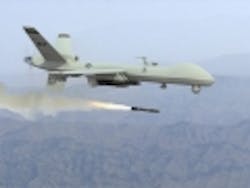Unmanned underwater vehicle machine autonomy seeks to detect and avoid fishing nets and kelp beds
NEWPORT, R.I., 12 Sept. 2010. The U.S. Navy depends increasing on unmanned underwater vehicle (UUV) technology for marine reconnaissance, surveillance, target acquisition, and other tasks with the potential to put human lives in danger. One of the biggest obstacles to effective UUV operations, however, involves fishing nets and kelp beds that threaten to entangle UUVs and cause damage or outright loss of these sophisticated underwater craft.
Researchers at the Naval Undersea Warfare Center (NUSC) in Newport, R.I., awarded two contracts late last week to give UUVs sufficient machine intelligence and autonomy not only to detect and avoid fishing nets, lines, boats, kelp and similar obstacles, but also to free themselves should they become entangled.
Fishing nets pose a threat to Navy UUVs, especially in coastal waters and harbors where fishing activity may be extremely heavy. It is in these so-called littoral areas where UUVs tend to be most useful for tasks like persistent surveillance, mine detection and removal, and target acquisition.
In these littoral waters, fishermen use a wide variety of tactics and nets of various sizes and shapes for subsistence and commercial fishing. Nets include gill nets, purse seine nets, trawl nets, lift nets, drift nets, and aquaculture nets made of assorted materials that can cover large areas of the ocean, which creates a physical barrer to UUVs moving through the area, naval researchers say.
NUSC officials on Thursday awarded a $219,000 research contract to the Charles Stark Draper Laboratory in Cambridge, Mass., and a $262,000 contract to Applied Physical Sciences Corp. (APS) in Groton, Conn., to find new technologies to improve the performance of UUVs in areas around the globe where fishing nets pose a threat.
Draper and APS experts will investigate sensors, and algorithms that enable UUVs to detect and avoid fishing nets, fishing lines, fishing boats, and kelp beds. Their solutions will be scalable for all classes of UUVs, with light- and heavy-weight vehicles of primary interest. Researchers also will investigate technology to enable UUVs to free themselves from fishing nets, lines, or kelp if entangled, as well as net-penetration equipment.
For more information contact the Naval Undersea Warfare Center Newport online at www.navsea.navy.mil/nuwc/newport, the Charles Stark Draper Lab at www.draper.com, or Applied Physical Sciences at www.aphysci.com.
